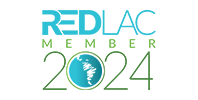Addressing Stony Coral Tissue Loss Disease in Lighthouse Reef Atoll
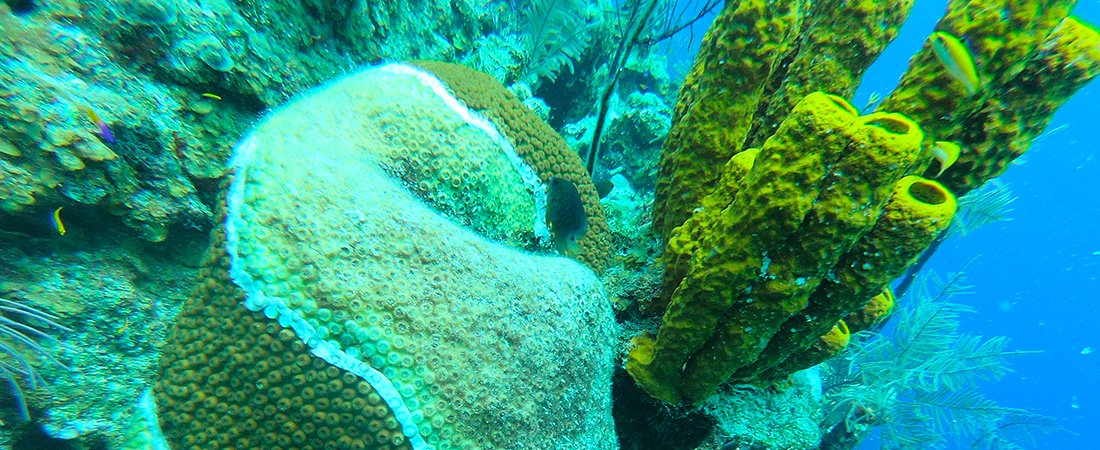
Affected corals in Half Moon Caye Natural Monument, the first marine protected area established in Belize and Central America. Photo: BAS
By Lucy Calderón
Healthy marine ecosystems are vital not only because of their beauty, but for all the ecosystem services they provide to coastal communities, in particular to the members of the tourism and fisheries sectors whose livelihoods depend on them.
So, when the Stony Coral Tissue Loss Disease (SCTLD) -a highly lethal, infectious disease that has devastated coral reefs throughout Florida since it was discovered in 2014 and spread rapidly throughout the wider Caribbean- was detected in Belize in recent years affecting also the Lighthouse Reef Atoll (LHRA), Dominique Lizama and her team at the Belize Audubon Society (BAS) decided to implement a project to counteract it.
Addressing the Onset of Stony Coral Tissue Loss Disease in Lighthouse Reef Atoll, Belize is the one-year project BAS developed to fight the effects of the SCTLD, supported by MAR Fund’s Small Grants Program under the Reef Rescue Initiative (RRI) window.
“Two of Belize’s most outstanding, highest priority and effectively managed marine protected areas are located within the Lighthouse Reef Atoll (LHRA)”, says Dominique Lizama, Conservation Program Director at BAS. These marine protected areas, The Blue Hole Natural Monument and Half Moon Caye Natural Monument, are co-managed by BAS.
As BAS is a member of the marine monitoring network, information about the SCTLD was shared by other members, including the Belize Fisheries Department (BFD). Everyone working in the conservation area had a general idea of what needed to be done.
However, what BAS’s staff and volunteers did not have, was the training to apply the treatment, which is why they incorporated a capacity building objective in the project; this and the other three objectives and its achievements are detailed in the following infographic:
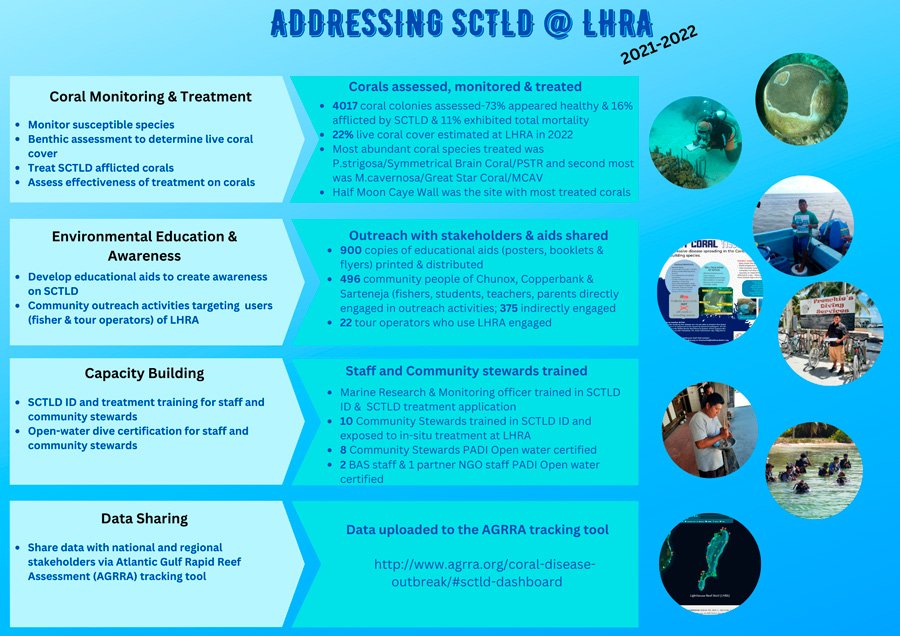
Infographic: BAS
Gabriela Ugarte, Marine Research and Monitor Officer at BAS explained that the training itself was only a week. However, it was a week well spent, since during this time BAS’ staff learned how to mix the treatment itself and then through some practical activities, they learned to identify the corals and to apply the substance.

SCTLD in-situ treatment application. Photo: BAS
Although the BAS project initially included the purchase of the treatment, BFD as the leading fisheries management body had already started treatment at their management sites, thus had already requested the local authorities to import the product: “CoreRX Base2B” and purchase the Amoxicillin that is mixed with it. For this reason, and because they had a surplus of the treatment, the members of the network were asked to request this surplus instead of buying more, and to use it in their protected area.
Gabriela commented that the treatment was successful because the disease did not progress any further and stopped where it was applied: “It stopped consuming the coral”, she says. “However, to confirm that the coral is completely healthy is difficult to say for sure, because corals take a long time to grow”, continues.
Dominique adds “when it comes to reef health, multiple factors must be taken into account. It’s not just about looking at the health of corals, but also the number and species of fish in the area, and the benthic organisms”.
“In general, in the Mesoamerican region and the Caribbean, and in marine conservation networks there is still not 100 percent certainty of what exactly is causing SCTLD. There is only the belief that the harmful agent is a bacterium. However, the use of CoreRX mixed with Amoxicillin helps, and it is a treatment that has proven effective from Florida to the Caribbean. It is a treatment previously tested in the U.S., in Mexico, the Caribbean and the BFD approved it for use in Belize”, Dominique explains.
“The project finished, and we are no longer applying for the treatment, however, since the treated sites are where we work permanently, we are always monitoring them. And we have noticed that where the treatment was applied, the disease no longer progressed”, Dominique says.
Environmental education for everyone
BAS continues its environmental education campaign to spread awareness on the SCTLD with all the public they meet that are related to marine conservation. They also continue to collect data and upload it to the Atlantic and Gulf Rapid Reef Assessment (AGRRA) monitoring tool, an open source that anyone can check.
In terms of community stewards, BAS has an existing program called Reef protectors program, which is a youth program where they work and select students from their stakeholder and northern fishing communities who use the LHRA to extract resources for their livelihoods. So, they already have a captive audience that helps them to share the information with their families.
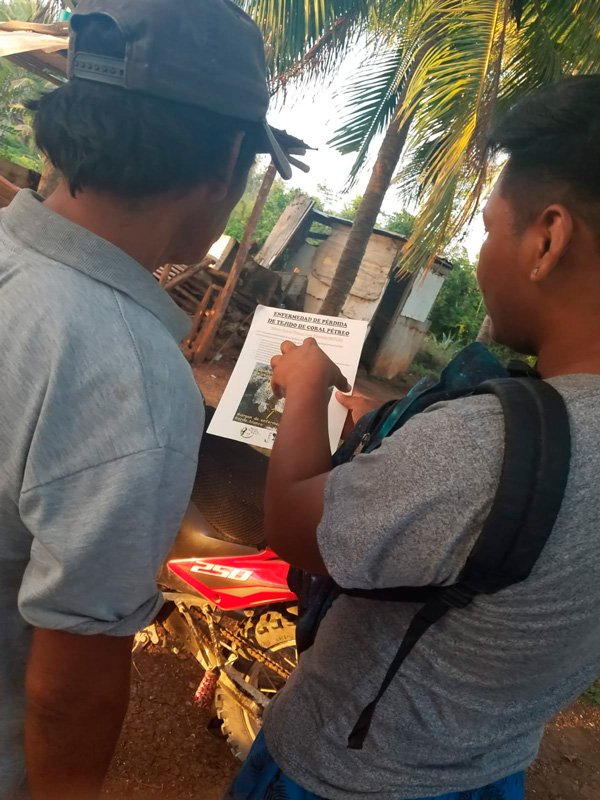
Reef Protector Community steward doing community outreach. Photo: BAS
“This two-year program is for students who have an interest in marine conservation; it is a very engaging one, a real-life experience on the marine environment, that will provide them with opportunities to become a marine biologist, an environmental educator, a tourism operator, or a ranger. However, if participants become fishers, hopefully, they would be more responsible; they would understand the importance of marine areas, and the protection of them for generations to come”, Dominique says.
The funds from MAR Fund helped support their two-year program, and even though the maximum that it takes to run the program exceeds the amount that they received from the RRI proposal, it blended really well, because for more than five years they had the support from the Belize Marine Fund.
Regarding fishers, BAS has an engaging program called Boat to Boat, a tool that they use for community outreach where their Community Liaison manager schedules visits and engagements with these fishermen.

Boat to Boat outreach to fishermen at LHRA. Photo: BAS
“If we reach fishers when they are sailing the Atoll, they are a captive audience and we make the most of the short interaction so as to not disrupt their routine. They are very receptive and over the years we have shared science information about the different species (lobster, conch, fin-fish) that they catch, fishery regulations, we also prepare flyers on specific topics (eg. reef grazers and SCTLD). Under this SCTLD project, we developed a booklet and a poster to share with their families afterwards.”
Fishers are also very good in providing them with information if they notice that something does not look good with the marine environment. “They know the area and are the first in these fishing grounds to see and detect changes; it is a two-way communication in terms of sharing what is happening in the marine environment and as well, we get information that relates to our enforcement efforts” she says.
Nationally the BFD and other partners are continuing the monitoring across the country in areas affected by SCTLD and the subsequent follow-up treatment.
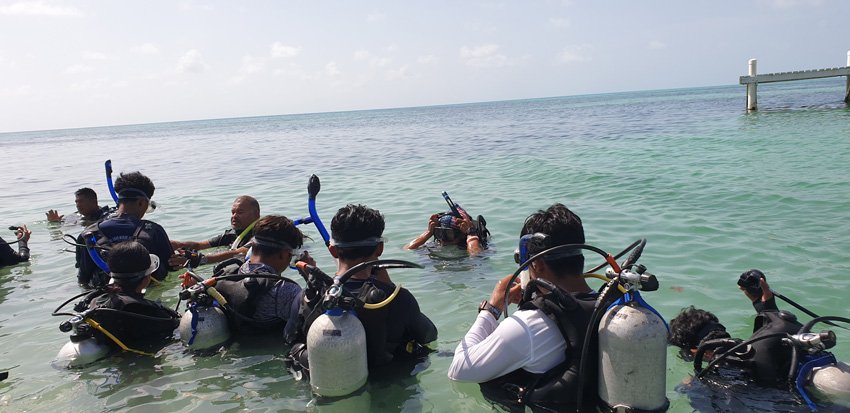
Dive certification training for community stewards. Photo: BAS

Half Moon Caye Photo: BAS
Gabriela and Dominique agree on the importance of continuing protecting and monitoring the reef health due to all the livelihoods that depend on them.
“For me, I think it goes back to the beauty of our country, and the fact that when I go to Half Moon and I am told that 30 years ago it was a significantly bigger island than the one it is today, it just makes me think what would happen if I do nothing, there would be people who would never see anything. So, I am doing my best to protect the beauty that I am able to see now”, Gabriela assures.
And, what motivates Dominique to continue her conservation work is related to how much their country has to offer in terms of marine tourism, the fishing industry and educational experiences: “I remember as a child being able to have that experience of the beauty that lies beneath the surface of the water. For me, it is a great satisfaction to share that experience with the young people we bring to Half Moon Caye, and also to think about how many people in the fishing sector depend on a healthy marine ecosystem. In our role as managers of these marine protected areas and, by extension, the LHRA, if we didn’t take enough care and make sure that our resources are protected, how many people would be affected? With SCTLD, one of the things that keeps me motivated and gives me hope is that we have a treatment that we know works and we’ve seen evidence of it, so it’s hopeful to know that at least by applying this treatment, the corals have a chance to continue to exist and provide their ecosystem services.”
However, “we need to continue working and researching in order to better understand the effects of SCTLD, because in the marine network we know that it works in a given timeframe, but what happens in the long-term afterwards? We need to know the genetics to understand if this disease has affected the corals internally for example, to continue mapping to evaluate how much area has been affected, and quantify the possible economic impact this disease has had on the ecosystem.This will take national and international effort.”
“The project was successful and BAS had the support of the marine network members (particularly BFD and Healthy Reef Initiative including technical advice and training for staff). Some challenges faced by BAS during the project included timely treatment and monitoring at the protected areas, due to remote location of the sites from headquarters, limitations brought on by COVID-19, packed schedules and inflation cost with the fuel” Dominique says. Despite all these, the staff at BAS are happy that the results can be of good use to the management of the area.
If you want to learn more about this project watch this video: http://ow.ly/5hfv50OiGSa



